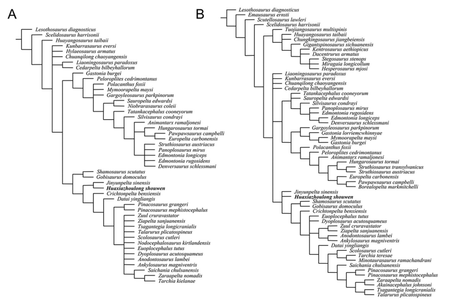Huaxiazhoulong
- unexpecteddinolesson
- Nov 10, 2024
- 2 min read
Updated: Mar 31
MEANING: Chinese armor dragon
PERIOD: Late Cretaceous
CONTINENT: Asia
Huaxiazhoulong is a fairly large ankylosaurid dinosaur, at around 6 m in length. It was a robust quadruped with a beak and teeth adapted for processing its herbivorous diet. Huaxiazhoulong had an armor of osteoderms, and the characteristic ankylosaurid tail club which was likely used in defense against predators, as well as intraspecific combat.

Abstract from paper: Huaxiazhoulong shouwen gen. et sp. nov. is a new ankylosaurid recovered from the Upper Cretaceous Tangbian Formation of Jiangxi Province, southern China. Huaxiazhoulong shouwen can be diagnosed on the basis of three autapomorphies (the middle shaft and distal end of the ischium are expanded; the ratio of width of distal end to minimum shaft width is greater than 3 in humerus, the maximum length of femur to humerus length ratio is about 1.45) and a unique combination of characters (the centra of anterior caudal vertebrae in anterior view is heart-shaped; the dorsal surface of scapula is straight; the scapulocoracoid has a large medial brace; the humeral head and deltopectoral crest are separated by a distinct notch anteriorly). The phylogenetic analysis shows that Huaxiazhoulong shouwen is an early member of Ankylosauridae.
Huaxiazhoulong is from the Cretaceous. The Cretaceous is a geological period that lasted from about 145 to 66 million years ago. It is the third and final period of the Mesozoic Era, as well as the longest. At around 79 million years, it is the longest geological period of the entire Phanerozoic. The name is derived from the Latin creta, "chalk", which is abundant in the latter half of the period.
The Cretaceous was a period with a relatively warm climate, resulting in high eustatic sea levels that created numerous shallow inland seas. These oceans and seas were populated with now-extinct flora and fauna, while dinosaurs continued to dominate on land. The world was ice free, and forests extended to the poles. During this time, new groups of mammals and birds appeared. During the Early Cretaceous, flowering plants appeared and began to rapidly diversify, becoming the dominant group of plants across the Earth by the end of the Cretaceous, coincident with the decline and extinction of previously widespread gymnosperm groups.
The Cretaceous (along with the Mesozoic) ended with the Cretaceous–Paleogene extinction event, a large mass extinction in which many groups, including non-avian dinosaurs, pterosaurs, and large marine reptiles, died out. The end of the Cretaceous is defined by the abrupt Cretaceous–Paleogene boundary (K–Pg boundary), a geologic signature associated with the mass extinction that lies between the Mesozoic and Cenozoic Eras.
Huaxiazhoulong is an ankylosaurid. Ankylosaurids are a family of armored dinosaurs within Ankylosauria, best known for the large bony clubs at the ends of their tails, distinguishing them from their nodosaurid relatives. Like all ankylosaurs, they were herbivorous, quadrupedal, and covered in bony osteoderms for defense. Ankylosaurids typically had broader, more triangular skulls, shorter limbs, and a more compact body compared to nodosaurids.
They first appeared in the Early Cretaceous and persisted until the end of the Mesozoic. Fossils of ankylosaurids are most commonly found in North America and Asia. Ankylosauridae and nodosauridae make up the larger group ankylosauria, which, along with the stegosaurs, form the group Thyreophora, known for their various combinations of armor and spikes.












